上海海事大学船舶无线电业务作业大题
- 格式:docx
- 大小:20.72 KB
- 文档页数:4
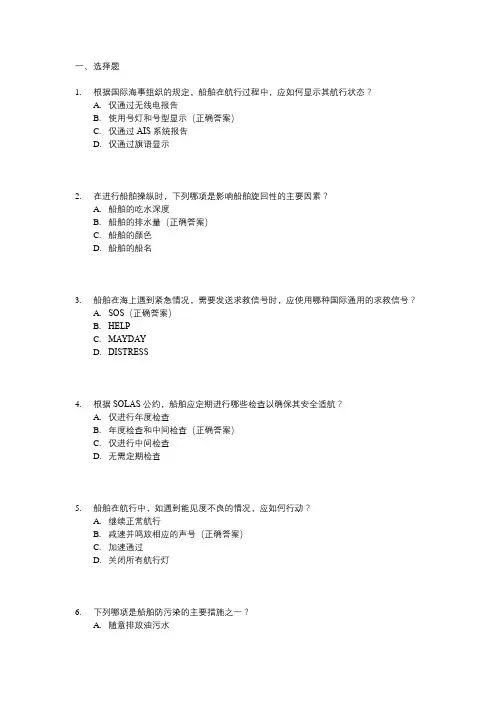
一、选择题
1.根据国际海事组织的规定,船舶在航行过程中,应如何显示其航行状态?
A.仅通过无线电报告
B.使用号灯和号型显示(正确答案)
C.仅通过AIS系统报告
D.仅通过旗语显示
2.在进行船舶操纵时,下列哪项是影响船舶旋回性的主要因素?
A.船舶的吃水深度
B.船舶的排水量(正确答案)
C.船舶的颜色
D.船舶的船名
3.船舶在海上遇到紧急情况,需要发送求救信号时,应使用哪种国际通用的求救信号?
A.SOS(正确答案)
B.HELP
C.MAYDAY
D.DISTRESS
4.根据SOLAS公约,船舶应定期进行哪些检查以确保其安全适航?
A.仅进行年度检查
B.年度检查和中间检查(正确答案)
C.仅进行中间检查
D.无需定期检查
5.船舶在航行中,如遇到能见度不良的情况,应如何行动?
A.继续正常航行
B.减速并鸣放相应的声号(正确答案)
C.加速通过
D.关闭所有航行灯
6.下列哪项是船舶防污染的主要措施之一?
A.随意排放油污水
B.使用低硫燃油(正确答案)
C.超量装载货物
D.忽略油水分离器的维护
7.在海事通信中,VHF(甚高频)无线电主要用于哪种通信?
A.卫星通信
B.船舶与船舶之间的近距离通信(正确答案)
C.深海潜水通信
D.跨洋长途通信
8.船舶在进港前,应向港口当局报告哪些信息?
A.船舶的建造年份
B.船舶的吃水、货物种类和预计抵港时间(正确答案)
C.船舶的船员名单
D.船舶的上次维修记录。
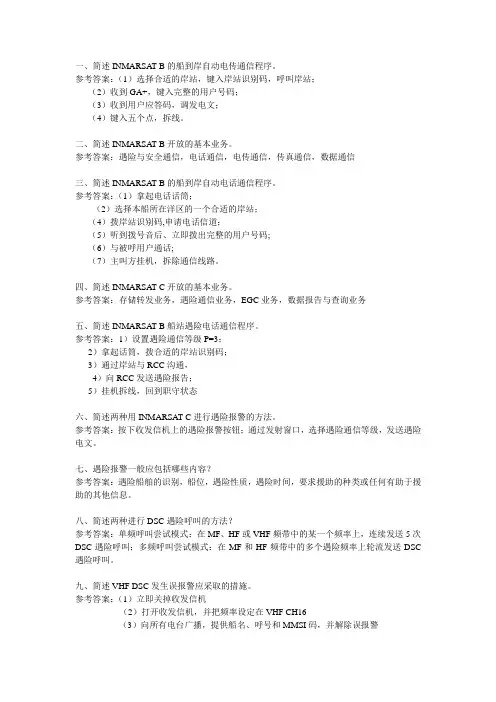
一、简述INMARSAT-B的船到岸自动电传通信程序。
参考答案:(1)选择合适的岸站,键入岸站识别码,呼叫岸站;(2)收到GA+,键入完整的用户号码;(3)收到用户应答码,调发电文;(4)键入五个点,拆线。
二、简述INMARSAT-B开放的基本业务。
参考答案:遇险与安全通信,电话通信,电传通信,传真通信,数据通信三、简述INMARSAT-B的船到岸自动电话通信程序。
参考答案:(1)拿起电话话筒;(2)选择本船所在洋区的一个合适的岸站;(4)拨岸站识别码,申请电话信道;(5)听到拨号音后、立即拨出完整的用户号码;(6)与被呼用户通话;(7)主叫方挂机,拆除通信线路。
四、简述INMARSAT-C开放的基本业务。
参考答案:存储转发业务,遇险通信业务,EGC业务,数据报告与查询业务五、简述INMARSAT-B船站遇险电话通信程序。
参考答案:1)设置遇险通信等级P=3;2)拿起话筒,拨合适的岸站识别码;3)通过岸站与RCC沟通,4)向RCC发送遇险报告;5)挂机拆线,回到职守状态六、简述两种用INMARSAT-C进行遇险报警的方法。
参考答案:按下收发信机上的遇险报警按钮;通过发射窗口,选择遇险通信等级,发送遇险电文。
七、遇险报警一般应包括哪些内容?参考答案:遇险船舶的识别,船位,遇险性质,遇险时间,要求援助的种类或任何有助于援助的其他信息。
八、简述两种进行DSC遇险呼叫的方法?参考答案:单频呼叫尝试模式:在MF、HF或VHF频带中的某一个频率上,连续发送5次DSC遇险呼叫;多频呼叫尝试模式:在MF和HF频带中的多个遇险频率上轮流发送DSC 遇险呼叫。
九、简述VHF DSC发生误报警应采取的措施。
参考答案:(1)立即关掉收发信机(2)打开收发信机,并把频率设定在VHF CH16(3)向所有电台广播,提供船名、呼号和MMSI码,并解除误报警十、简述MF DSC发生误报警应采取的措施。
参考答案:(1)立即关掉收发信机(2)打开收发信机,并把频率设定在2182KHz(3)向所有电台广播,提供船名、呼号和MMSI码,并解除误报警十一、简述HF DSC发生误报警应采取的措施。
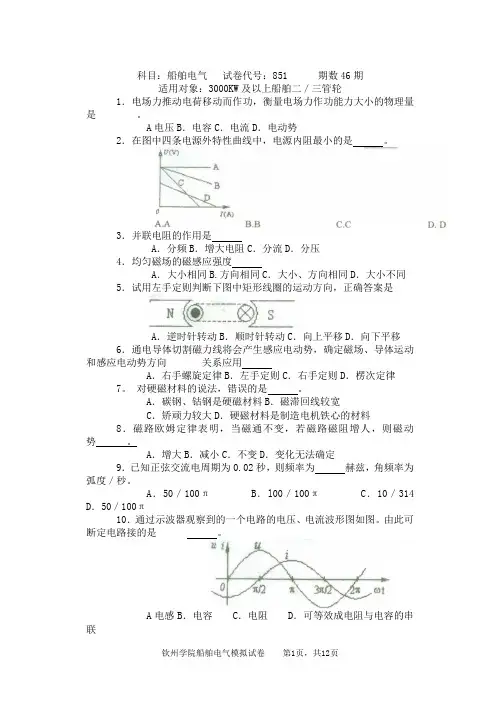
科目:船舶电气试卷代号:851 期数46期适用对象:3000KW及以上船舶二/三管轮1.电场力推动电荷移动而作功,衡量电场力作功能力大小的物理量是。
A电压B.电容C.电流D.电动势2.在图中四条电源外特性曲线中,电源内阻最小的是。
3.并联电阻的作用是A.分频B.增大电阻C.分流D.分压4.均匀磁场的磁感应强度A.大小相同B.方向相同C.大小、方向相同D.大小不同5.试用左手定则判断下图中矩形线圈的运动方向,正确答案是A.逆时针转动B.顺时针转动C.向上平移D.向下平移6.通电导体切割磁力线将会产生感应电动势,确定磁场、导体运动和感应电动势方向关系应用A.右手螺旋定律B.左手定则C.右手定则D.楞次定律7。
对硬磁材料的说法,错误的是。
A.碳钢、钴钢是硬磁材料B.磁滞回线较宽C.矫顽力较大D.硬磁材料是制造电机铁心的材料8.磁路欧姆定律表明,当磁通不变,若磁路磁阻增人,则磁动势。
A.增大B.减小C.不变D.变化无法确定9.已知正弦交流电周期为0.02秒,则频率为赫兹,角频率为弧度/秒。
A.50/100π B.l00/100π C.10/314 D.50/100π10.通过示波器观察到的一个电路的电压、电流波形图如图。
由此可断定电路接的是。
A电感B.电容 C.电阻 D.可等效成电阻与电容的串联11.单相交流电路的电压幅值为Um,电流幅值为Im,则视在功率S 为。
12.一对称三相电源给对称三相负载供电如图,三相电源线电压为380V,负载电阻RA=RB=RC=220V.则流过各相负载电阻的电流、各相负载端电压分别为。
13.一般说来,本征半导体的导电能力,当掺入某些适当微量元素后其导电能力_。
A很强/更强B.很强/降低C.很弱/提高D.很弱/更弱14.如图,设输人信号U为正弦波,幅值为1伏,二极管导通时的正向电压降为0.6V,关于输出信号Uo的说法,正确的是输出电压值范围介于间。
15.某单相半波整流电路直接接有电阻负载,负载平均电流为90mA,整流电路输人的交流电压有效值为24V,关于选择整流二极管的参数(最大整流电流IDM。
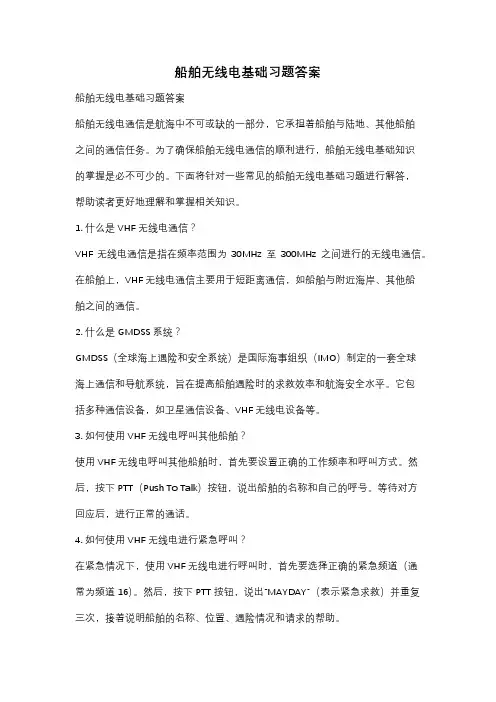
船舶无线电基础习题答案船舶无线电基础习题答案船舶无线电通信是航海中不可或缺的一部分,它承担着船舶与陆地、其他船舶之间的通信任务。
为了确保船舶无线电通信的顺利进行,船舶无线电基础知识的掌握是必不可少的。
下面将针对一些常见的船舶无线电基础习题进行解答,帮助读者更好地理解和掌握相关知识。
1. 什么是VHF无线电通信?VHF无线电通信是指在频率范围为30MHz至300MHz之间进行的无线电通信。
在船舶上,VHF无线电通信主要用于短距离通信,如船舶与附近海岸、其他船舶之间的通信。
2. 什么是GMDSS系统?GMDSS(全球海上遇险和安全系统)是国际海事组织(IMO)制定的一套全球海上通信和导航系统,旨在提高船舶遇险时的求救效率和航海安全水平。
它包括多种通信设备,如卫星通信设备、VHF无线电设备等。
3. 如何使用VHF无线电呼叫其他船舶?使用VHF无线电呼叫其他船舶时,首先要设置正确的工作频率和呼叫方式。
然后,按下PTT(Push To Talk)按钮,说出船舶的名称和自己的呼号。
等待对方回应后,进行正常的通话。
4. 如何使用VHF无线电进行紧急呼叫?在紧急情况下,使用VHF无线电进行呼叫时,首先要选择正确的紧急频道(通常为频道16)。
然后,按下PTT按钮,说出“MAYDAY”(表示紧急求救)并重复三次,接着说明船舶的名称、位置、遇险情况和请求的帮助。
5. 如何进行VHF无线电通信的监听?进行VHF无线电通信的监听时,应选择正确的工作频率,并将接收器调至相应频率。
同时,要确保接收器的音量调节适中,以免错过重要的通信信息。
6. 什么是EPIRB?EPIRB(紧急位置指示无线电信标)是一种用于发射紧急信号的设备,主要用于船舶遇险时的求救。
它能够通过卫星定位系统(如GPS)确定船舶的位置,并发出求救信号,以便救援人员能够及时找到遇险船舶。
7. 如何使用EPIRB进行求救?使用EPIRB进行求救时,首先要确保EPIRB的电源开关打开,并将其放置在船舶上易于寻找的位置。
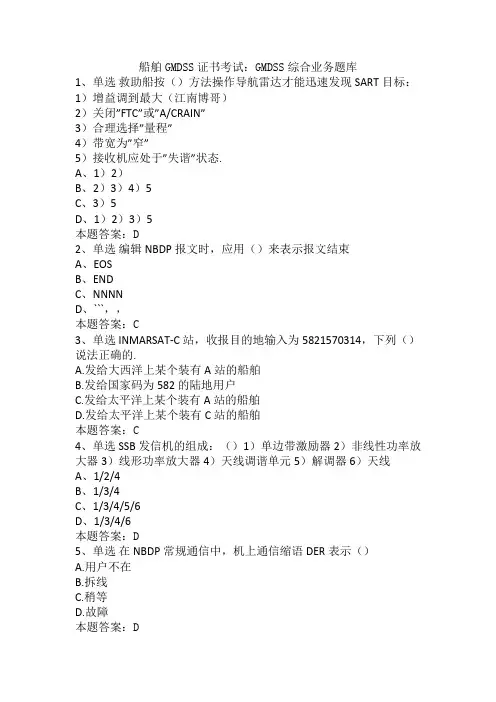
船舶GMDSS证书考试:GMDSS综合业务题库1、单选救助船按()方法操作导航雷达才能迅速发现SART目标:1)增益调到最大(江南博哥)2)关闭”FTC”或”A/CRAIN”3)合理选择”量程”4)带宽为”窄”5)接收机应处于”失谐”状态.A、1)2)B、2)3)4)5C、3)5D、1)2)3)5本题答案:D2、单选编辑NBDP报文时,应用()来表示报文结束A、EOSB、ENDC、NNNND、```,,本题答案:C3、单选 INMARSAT-C站,收报目的地输入为5821570314,下列()说法正确的.A.发给大西洋上某个装有A站的船舶B.发给国家码为582的陆地用户C.发给太平洋上某个装有A站的船舶D.发给太平洋上某个装有C站的船舶本题答案:C4、单选 SSB发信机的组成:()1)单边带激励器2)非线性功率放大器3)线形功率放大器4)天线调谐单元5)解调器6)天线A、1/2/4B、1/3/4C、1/3/4/5/6D、1/3/4/6本题答案:D5、单选在NBDP常规通信中,机上通信缩语DER表示()A.用户不在B.拆线C.稍等D.故障本题答案:D6、单选 SART与X波段RADAR配合,不能完成功能是:()A.通信B.报警C.A+BD.寻位本题答案:C7、单选在ARQ通信中,如下情况时IRS发与前一次不同控制信号CS1或CS2()A、所收三个字符都符合4B3YB、所收一个字符都符合4Y3BC、所收三个字符中有2个符合4B3Y,另一个符合4Y3BD、所收三个字符都不符合4B3Y本题答案:A8、单选 MF/HFDSC呼叫,其电波采用什么方式传播()A、天波B、地波C、空间波D、A+B本题答案:D9、单选有关EPIRB的说法是不正确的是()A、EPIRB是船舶遇险时的主要报警设备B、EPIRB是船舶遇险时的辅助报警设备C、EPIRB报警称为船对岸的报警D、EPIRB报警后与RCC的通信称为遇险通信本题答案:D10、单选航行中发现一不明漂浮物,本船准备用NBDP设备向附近船舶广播,应使用()方式A、ARQB、SFECC、CFECD、GROUPCALL本题答案:C11、单选电离层的特点是:()1.对频率高的无线电波吸收大,因此使天线传播距离近2.对频率低的无线电波吸收大,因此使天线传播距离近3.电离层浓度高,静区大4.电离层浓度低,静区大5.通常白天电离层浓度高,晚上低6.晚间、白衣电离层浓度不变A、1/4/5B、2/3/5C、2/4/5D、1/3/6本题答案:C12、单选用B站与上海(021)一航运代理(TEL:53931500)通话,应拨号()A.008621539315003#B.002153931500#C.8602153931500#D.00852153931500#本题答案:A13、单选在EGC系统中,向特定船队播发有关公司新闻、政府广播信息,应属于()业务.A、FLEETNETB、SAFETYNETC、SYSTEM/MESSAGED、MSI本题答案:A14、单选在A3海区船行的船舶,为完成船岸间日常通信,必须配备的通信设备是:()A.带DSC的VHF无线电话B.带DSC的MF/HF单边无线电话C.INMARSAT卫星船站D.B或C本题答案:D15、单选当救助艇驶向SART约()时,雷光荧光屏上SART信号呈同芯圆.A.100米B.500米C.1海里D.5海里本题答案:B16、单选接收TELEX信号时,AGC开关应置于()位A、快B、断开C、慢D、A/B本题答案:D17、单选 AMVER报告电文的第一行为AMVER/SP/的是()报告A、离港B、船位C、航行计划D、偏差本题答案:C18、单选 DSC遇险报警启动后如没有收到遇险确认,该设备约()分钟间隔自动重发.A、1B、2.5C、4D、10本题答案:C19、单选 NAVTEX电报的技术编码中,B2表示()A、发射电台B、电报种类C、报文编号D、洋区代号本题答案:B20、单选 NBDP的码元中,空号对应的单频为:()A.1415HZB.1500HZC.1785HZD.1615HZ本题答案:C21、单选 6GHz是海事卫星通信()使用的频率A、星对船B、船对星C、岸对星D、星对岸本题答案:C22、单选 COSPAS-SARSAT卫星系统由()组成1)COSPAS/SARSAT卫星2)INMARSAT卫星和COSPAS/SARSAT卫星3)岸站和船站4)406MHZEPIRB和本地用户终端5)任务控制中心和搜救协调中心6)网络协调和运行控制中心A.1)3)4)6)B.1)4)5)C.1)3)4)5)6)D.1)4)本题答案:D23、单选安装在救生艇上的卫星示位标内的SART,有关应答信号发射正确的是()A、当卫星示位标置于自动位置时,SART就自动发射应答信号B、当卫星示位标置于手动位置时,SART自动发射应答信号C、当卫星示位标浸入水中,无论在自动或手动位置,SART被X波段雷达信号触发后就发射应答信号D、置SART在自动位置,它将自动发射应答信号本题答案:C24、单选酸性畜电池与碱性电池每节电压为:()A.2.0/1.5vB.2.0/1.25vC.2.5/1.5vD.2.5/1.25v本题答案:B25、单选岸台在收到VHF/DSC遇险呼叫后,在下列()分钟时间内应答A、3.5-4.5B、1-1.5C、1-2.75D、马上本题答案:D26、单选承担GMDSS守听责任的()对由空间站转发的遇险信号应保持连续的自动守听.A、岸台B、岸站C、船舶电台D、A/B/C本题答案:B27、单选在A1海区航行的船舶,为完成船岸间日常通信,必须配备的通信设备是:()A.带DSC的VHF无线电话B.带DSC的MF/HF无线电设备C.INMARSAT卫星船站D.A+B+C本题答案:A28、单选单边带发射机中载波应用()电路产生A.LC振荡器B.晶体振荡器C.频率合成器D.RC振荡器本题答案:C29、单选单边带发射机采用三次搬频方案,则第三次混频输出采用()A、高通滤波器B、带通滤波器C、带阻滤波器D、低通滤波器本题答案:D30、单选 NBDP的FEC方式汇总,保证BRS与BSS间同步的定相信号是()A.0.1点阵信号B.RQ,aC.RQD.a本题答案:B船舶GMDSS证书考试:GMDSS综合业务试题考点巩固1、单选船舶的无线电话通信工作频率,最终由()决定.A、呼叫船B、被呼叫船C、呼叫序列D、应答序列本题答案:B2、单选 VHF通信,其电波采用()传播A.天波B.地波C.空间波D.波导本题答案:C3、单选经事先约定本船准备使用NBDP设备向停靠在港内的某船盲发一份电报,工作方式应使用()A、SFECB、CFECC、ARQD、SSB本题答案:A4、单选在GMDSS中的现场通信用()设备进行。
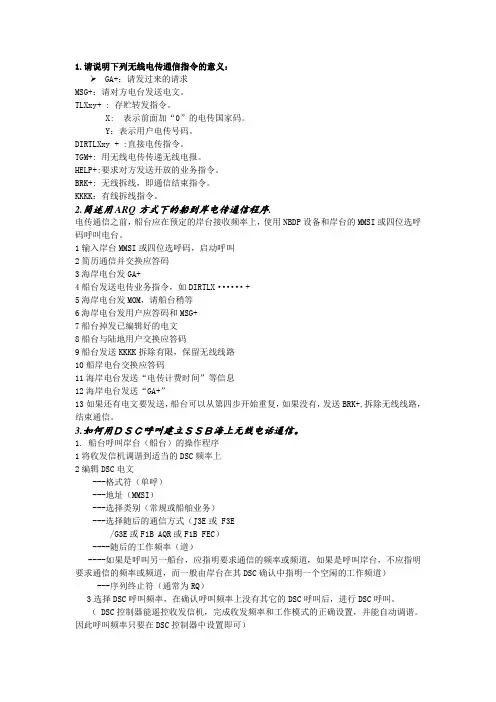
1.请说明下列无线电传通信指令的意义:GA+:请发过来的请求MSG+:请对方电台发送电文。
TLXxy+ : 存贮转发指令。
X: 表示前面加“0”的电传国家码。
Y:表示用户电传号码。
DIRTLXxy + :直接电传指令。
TGM+: 用无线电传传递无线电报。
HELP+:要求对方发送开放的业务指令。
BRK+: 无线拆线,即通信结束指令。
KKKK:有线拆线指令。
2.简述用ARQ方式下的船到岸电传通信程序.电传通信之前,船台应在预定的岸台接收频率上,使用NBDP设备和岸台的MMSI或四位选呼码呼叫电台。
1输入岸台MMSI或四位选呼码,启动呼叫2简历通信并交换应答码3海岸电台发GA+4船台发送电传业务指令,如DIRTLX······+5海岸电台发MOM,请船台稍等6海岸电台发用户应答码和MSG+7船台掉发已编辑好的电文8船台与陆地用户交换应答码9船台发送KKKK拆除有限,保留无线线路10船岸电台交换应答码11海岸电台发送“电传计费时间”等信息12海岸电台发送“GA+”13如果还有电文要发送,船台可以从第四步开始重复,如果没有,发送BRK+,拆除无线线路,结束通信。
3.如何用DSC呼叫建立SSB海上无线电话通信。
1. 船台呼叫岸台(船台)的操作程序1将收发信机调谐到适当的DSC频率上2编辑DSC电文---格式符(单呼)---地址(MMSI)---选择类别(常规或船舶业务)---选择随后的通信方式(J3E或 F3E/G3E或F1B AQR或F1B FEC)----随后的工作频率(道)----如果是呼叫另一船台,应指明要求通信的频率或频道,如果是呼叫岸台,不应指明要求通信的频率或频道,而一般由岸台在其DSC确认中指明一个空闲的工作频道)---序列终止符(通常为RQ)3选择DSC呼叫频率,在确认呼叫频率上没有其它的DSC呼叫后,进行DSC呼叫。
( DSC控制器能遥控收发信机,完成收发频率和工作模式的正确设置,并能自动调谐。
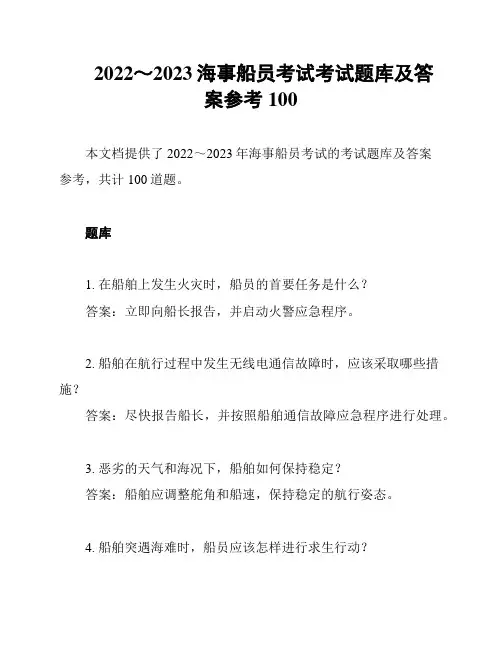
2022~2023海事船员考试考试题库及答
案参考100
本文档提供了2022~2023年海事船员考试的考试题库及答案
参考,共计100道题。
题库
1. 在船舶上发生火灾时,船员的首要任务是什么?
答案:立即向船长报告,并启动火警应急程序。
2. 船舶在航行过程中发生无线电通信故障时,应该采取哪些措施?
答案:尽快报告船长,并按照船舶通信故障应急程序进行处理。
3. 恶劣的天气和海况下,船舶如何保持稳定?
答案:船舶应调整舵角和船速,保持稳定的航行姿态。
4. 船舶突遇海难时,船员应该怎样进行求生行动?
答案:佩戴救生衣,尽快登上救生艇,并按照救生艇使用手册进行操作。
...
答案参考
1. 火灾发生时,船员的首要任务是立即向船长报告,并启动火警应急程序。
2. 在航行过程中发生无线电通信故障时,应该尽快报告船长,并按照船舶通信故障应急程序进行处理。
3. 恶劣的天气和海况下,船舶应调整舵角和船速,保持稳定的航行姿态。
4. 船舶突遇海难时,船员应该佩戴救生衣,尽快登上救生艇,并按照救生艇使用手册进行操作。
...
100. 题目100的答案。
请注意,题库中的题目和答案仅供参考,具体考试内容以实际考试为准。
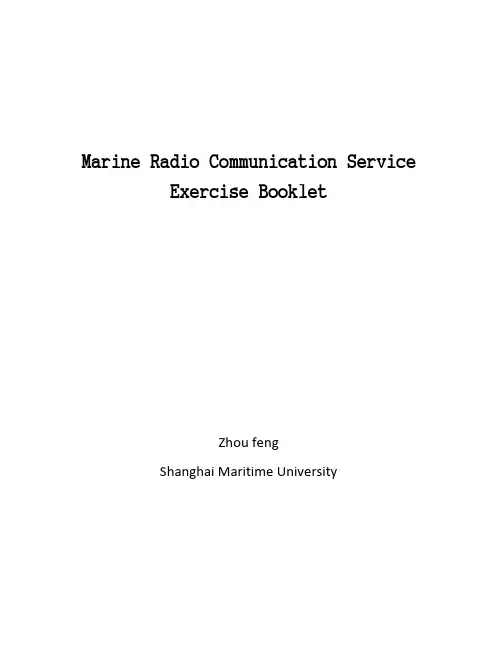
Marine Radio Communication ServiceExercise BookletZhou fengShanghai Maritime UniversitySection-A: General Information and System Overview. Key Topic #1: Fundamental Concepts:1A1 What is the fundamental concept of the GMDSS?A. GMDSS utilizes automated systems and satellite technology to improve emergency communications for the world’s shipping industry.B. It is intended to automate and improve existing digital selective calling procedures and techniques.C. It is intended to provide more effective but lower cost commercial communications.D. It is intended to provide compulsory vessels with a collision avoidance system when they are operating in waters that are also occupied by non-compulsory vessels.1A2 The primary purpose of the GMDSS is:A. Allow more effective control of SAR situations by vessels.B. Automate and improve emergency communications for the world's shipping industry.C. Provide additional shipboard systems for more effective company communications.D. Effective and inexpensive communications.1A3 What is the basic concept of GMDSS?A. Shoreside authorities will rely on reports from nearby vessels to become aware of Distress alerts.B. Shoreside authorities and vessels can assist in a coordinated SAR operation only after the correct chain of DSC relays takes place.C. SAR authorities ashore can be alerted to a Distress situation & shipping in the vicinity can be requested to participate in SAR operations.D. SAR authorities ashore wait to have EPIRB Distress alerts confirmed by satellite follow-on communications.1A4 GMDSS is primarily a system based on:A. Ship-to-ship Distress communications using MF or HF radiotelephony.B. VHF digital selective calling from ship to shore.C. Distress, Urgency and Safety communications carried out by the use of narrow-band direct printing telegraphy.D. The linking of search and rescue authorities ashore with shipping in the immediate vicinity of a ship in Distress or in need of assistance.1A5 What is the responsibility of compulsory GMDSS vessels?A. Every vessel must be able to perform communications functions essential for its own safety and the safety of other vessels.B. Vessels must transmit a DSC distress relay upon receipt of a DSC distress alert.C. Only the vessels closest to a Distress incident must render assistance.D. Vessels must immediately acknowledge all DSC distress alerts.1A6 GMDSS is required for which of the following?A. All vessels capable of international voyages.B. SOLAS Convention ships of 300 gross tonnage or more.C. Vessels operating outside of the range of VHF coast radio stations.D. Coastal vessels of less than 300 gross tons.Answers - 1A1 - A 1A2 - B 1A3 - C 1A4 - D 1A5 - A 1A6 - BSection-A: General Information and System Overview. Key Topic #2: Equipment Systems:2A1 Which GMDSS system utilizes terrestrial radio techniques?A. F-77B. Inmarsat-CC. GPSD. VHF-MF-HF-DSC2A2 What equipment utilizes satellite communications?A. Inmarsat-CB. VHF-MF-HFC. NAVTEXD. SART2A3 What equipment is used in or near the survival craft?A. NAVTEXB. EPIRBC. FathometerD. COSPAS-SARSAT2A4 What equipment is programmed to initiate transmission of Distress alerts and calls to individual stations?A. NAVTEXB. GPSC. DSC ControllerD. DSC Scanning Watch Receiver2A5 What system provides accurate vessel position information to the GMDSS equipment?A. COSPAS-SARSATB. EPIRBC. GPSD. Inmarsat-B2A6 Which of these can be used to receive MSI?A. SARTB. EPIRBC. Inmarsat-BD. NAVTEXAnswers: 2A1 - D 2A2 - A 2A3 - B 2A4 - C 2A5 - C 2A6 - DSection-A: General Information and System Overview. Key Topic #3: Sea Areas:3A1 Which of the following regions lie outside Sea Areas A1, A2, and A3?A. Sea Areas only apply to Inmarsat footprint areas.B. Sea Area A3-I Inmarsat coverage and Sea Area A3-S HF SITOR (NBDP) coverage.C. Sea Area A4D. There are no additional Sea Areas.3A2 What sea area is defined as being within range of a shore-based MF station that provides for continuous DSC alerting?A. Coastal watersB. Sea area A3C. Sea area A1D. Sea area A23A3 If a vessel is engaged in local trade and at no point in its voyage travels outside the range of a VHF shore station with continuous DSC alerting then the vessel is operating in what area?A. Sea area A1B. Coastal and international zonesC. Inland and coastal watersD. Sea areas A1 and A23A4 What is defined as an area, excluding sea areas A1 and A2, within the coverage of an Inmarsat geostationary satellite in which continuous alerting is available?A. Ocean Area Regions AOR-E, AOR-W, POR or IORB. Sea Area A3C. Sea Area A4D. Coastal and Inland Waters3A5 SITOR (NBDP) equipment is a partial or alternate carriage requirement under GMDSS for vessels operating in which sea area(s)?A. A1B. A3 and A4C. A1 and A2D. A1, A2, A3 and A43A6 What is defined as the area within the radiotelephone coverage area of at least one VHF coast station in which continuous DSC alerting is available as defined by the IMO regulation for GMDSS?A. Ocean Area Regions AOR-E, AOR-W, POR or IORB. Sea Area A2C. Sea Area A1D. Coastal and Inland WatersAnswers: 3A1 - C 3A2 - D 3A3 - A 3A4 - B 3A5 - B 3A6 - C4A1 Which of the following is a functional or carriage requirement for compulsory vessels?A. A compulsory vessel must carry at least two (2) FCC licensed GMDSS Radio Operators in all sea areas as well as a GMDSS Maintainer in sea areas A3 & A4.B. A compulsory vessel must satisfy certain equipment carriage requirements based on the intended sea area of operation.C. A compulsory vessel must be able to transmit and respond to Distress alerts and carry only one (1) FCC licensed GMDSS Radio Operator in sea areas A1 & A2.D. None of these answers are correct.4A2 Which GMDSS communication functions must all compulsory vessels be capable of performing to meet International Maritime Organization requirements?A. Distress alerting and receipt of Maritime Safety Information via Inmarsat for all vessels intending to operate in Sea Area A4.B. Distress alerting and receipt of MSI in Sea Areas A1, A2, A3, and A4 regardless of the vessel's intended area of operation.C. Distress alerting, general communications and receipt of Maritime Safety Information in the vessel's intended area of operation.D. General communications via Inmarsat and receipt of Maritime Safety Information via Enhanced Group Calling in Sea Area A4.4A3 GMDSS-equipped ships will be required to perform which of the following communications functions?A. Distress alerting, MSI, SAR and on-scene communications & receipt of satellite alerts from other vessels.B. SAR and on-scene communications, Bridge-to-Bridge and general radio communications, MSI and relay of satellite alerts from other vessels.C. Bridge-to-Bridge and general radio communications, RDF of EPIRB homing signals, Distress alerting and MSI.D. Transmit distress alerts, SAR and on-scene communications, MSI, Bridge-to-Bridge and general radio communications.4A4 What equipment can be used to receive Maritime Safety Information?A. NAVTEX, EGC receiver or HF SITOR (NBDP).B. EGC receiver, Inmarsat B or F77 terminal.C. HF SITOR (NBDP), Inmarsat B or NAVTEX.D. All of these answers are correct.4A5 Which of the following are required GMDSS functions?A. Bridge-to-Bridge communications, reception of weather map facsimile broadcasts, SAR communications.B. Reception of weather map facsimile broadcasts, receiving company email, On-scene communications.C. Reception of VHF weather channels, On-scene communications, general communicationsD. Bridge-to-Bridge communications, general communications, SAR communications.4A6 Which of the following are required GMDSS functions for vessels?A. Transmit and receive locating signals, general communications and SAR communications.B. Transmit and receive general communications, transmit Distress Alerts by at least one means, MSI.C. Transmit and receive locating signals, send MSI to other ships via EGC, Bridge-to-Bridge communications.D. Transmit and receive SAR communications, transmit Distress Alerts by at least one means, Bridge-to-Bridge communications.Answers: 4A1 - B 4A2 - C 4A3 - D 4A4 - A 4A5 - D 4A6 - A5A1 Which statement is true regarding a vessel equipped with GMDSS equipment that will remain in Sea AreaA1 at all times?A. The vessel must be provided with a radio installation capable of initiating the transmission of ship-to-shore Distress alerting from the position from which the ship is normallynavigated. B. VHF DSC alerting may be the sole means of Distressalerting.C. HF or MF DSC may satisfy the equipment requirement.D. HF SSB with 2182 kHz automatic alarm generator may satisfy the equipment requirement.5A2 What statement is true regarding the additional equipment carriage requirement imposed for the survival craft of vessels over 500 gross tons?A. Additional carriage of two radio equipped lifeboatsaft. B. A second radar transponder is required.C. Four additional portable VHF radios are required.D. The ability to communicate in all modes with any shore station.5A3 Vessels operating in which sea area(s) are required to carry either Inmarsat or HF equipmentor a combination thereof under GMDSS?A. All sea areasB. A4C. A3D. A15A4 Within a single sea area, what is the primary reason GMDSS imposes carriage requirements for different radio subsystems?A. Redundancy in duplicating all operational functions in the event of a system failure.B. Different subsystems are required to meet the specific equipment carriage requirements ofnational authorities.C. GMDSS vessels must be equipped to communicate in all modes with coast radio stations.D. The combined capabilities of redundant subsystems mitigate the risk of a single point of failure.5A5 If operating within Ocean Area A1, and outside of NAVTEX coverage, a GMDSS-equipped vesselmust carry:A. Equipment capable of reception of Maritime Safety Information by the Inmarsat enhanced group call system, or HF SITOR (NBDP).B. A GPS receiver.C. Equipment capable of maintaining a continuous DSC watch on 2187.5kHz. D. An Inmarsat-B terminal.5A6 What is the equipment carriage requirement for survival craft under GMDSS?A. At least three SCT units and two SARTs on every cargo ship between 300-500 gross tons and the same on all passenger ships regardless of tonnage.B. At least three SCT units and two SARTs on every passenger ship and cargo ships of 500 gross tonsand upwards.C. At least two radar transponders must be carried on every cargo ship of 300-500 gross tons and tworadar transponders (one for each side) of every passenger ship regardless of tonnage.D. All cargo vessels above 300 gross tons and every passenger ship regardless of tonnage must carry three SCT units and two SARTs.Answers: 4A1 - B 4A2 - C 4A3 - D 4A4 - A 4A5 - D 4A6 - ASection-C: F.C.C. Rules & Regulations: Key Topic #16: License and Personnel Requirements:16C1 Which FCC license meets the requirement to serve as a GMDSS operator?A. General Radiotelephone Operator’s License.B. GMDSS Radio Operator’s LicenseC. Marine Radio Operator’s Permit.D. GMDSS Radio Maintainer’s License.16C2 Which of the following statements concerning GMDSS Radio Operator requirements is false?A. Each compulsory vessel must carry at least two licensed GMDSS Radio Operators at all times while at sea.B. Each compulsory vessel must carry at least two licensed GMDSS Radio Operators at all times while at sea and may elect to carry a GMDSS Radio Maintainer as well.C. All communications involving Safety of life at sea must be logged as long as the compulsory vessel was not involved in such communications.D. While at sea, adjustments to, and the maintaining of, GMDSS equipment may be performed by the GMDSS Radio Operator as long as the work is supervised by an on-board licensed GMDSS Radio Maintainer.16C3 Which FCC license meets the requirements to perform or supervise the performance of at-sea adjustments, servicing, or maintenance which may affect the proper operation of the GMDSS station?A. General Radiotelephone Operator’s License with Shipboard RADAR endorsement.B. Marine Radio Operator’s Permit or GMDSS Maintainer’s license.C. GMDSS Radio Operator’s license or Marine Radio Operator’s Permit.D. GMDSS Operator’s/Maintainer’s license or GMDSS Maintainer’s license.16C4 Which statement is false regarding the radio operator requirements for a GMDSS-equipped ship station?A. Maintaining a record of all incidents connected with the radio-communications service that appear to be of importance to Safety of life at sea is not required.B. One of the qualified GMDSS radio operators must be designated to have primary responsibility for radio- communications during Distress incidents.C. A qualified GMDSS radio operator, and a qualified backup, must be designated to perform Distress, Urgency and Safety communications.D. While at sea, all adjustments or radio installations, servicing or maintenance of such installations that may affect the proper operation of the GMDSS station must be performed by, or under the supervision of, a qualified GMDSS radio maintainer.16C5 Which of the following are personnel, functional, or equipment FCC requirements of the GMDSS?A. One FCC licensed GMDSS radio operator in sea areas A1 & A2, two FCC licensed GMDSS radio operators in sea areas A3 & A4 and equipment carriage based on intended sea area of operations.B. Distress alerting and response, two USCG STCW GMDSS watchstanders, equipment carriage based on intended sea area of operations.C. Equipment carriage reduced for sea areas A3 & A4, Distress alerting and response and two FCC licensed GMDSS radio operators.D. Equipment carriage based on intended sea area of operations, distress alerting and response and two FCC licensed GMDSS radio operators.16C6 How many GMDSS radio maintainers must be carried aboard a compulsory vessel if the At-Sea maintenance method is used?A. One regardless of sea area of operation.B. Two in Sea Areas A3 and A4.C. Two in Sea Area A1.D. None of these answers are correct.Answers: 16C1 - B 16C2 - C 16C3 - D 16C4 - A 16C5 - D 16C6 - ASection-C: F.C.C. Rules & Regulations: Key Topic #16: Reserve Source of Energy:17C1 Which statement is false regarding the GMDSS requirement for ship sources of energy?A. The reserve sources of energy need to supply independent MF and HF radio installations at the same time.B. At all times while the vessel is at sea, a sufficient supply of electrical energy to operate the radio installations and charge any batteries which may be part of the reserve source of energy is required.C. An uninterruptible power supply or other means of ensuring a continuous supply of electrical power to all GMDSS equipment that could be affected by normal variations and interruptions of ship's power is required.D. If a vessel’s position is constantly required for the proper performance of a GMDSS station, provisions must be made to ensure position information is uninterrupted if the ship’s source of main or emergency energy fails.17C2 What is the meaning of “Reserve Source of Energy”?A. High caloric value items for lifeboat, per SOLAS regulations.B. Power to operate the radio installation and conduct Distress and Safety communications in the event of failure of the ship's main and emergency sources of electrical power.C. Diesel fuel stored for the purpose of operating the powered survival craft for a period equal to or exceeding the U.S.C.G. and SOLAS requirements.D. The diesel fueled emergency generator that supplies AC to the vessel’s Emergency power bus.17C3 Which term describes the source of energy required to supply the GMDSS console with power if the ship’s source of main or emergency energy fails?A. Emergency powerB. Ship's emergency diesel generatorC. Reserve Source of EnergyD. Ship's standby generator17C4 What characteristics describe the GMDSS Reserve Source of Energy (RSE)?A. Supplies independent HF and MF installations at the same time.B. Cannot be independent of the propelling power of the ship.C. Must be incorporated into the ship's electrical system.D. Must be independent of the ship's electrical system when the RSE is needed to supply power to the GMDSS equipment.17C5 What is the requirement for emergency and reserve power in GMDSS radio installations?A. Compulsory ships must have emergency and reserve power sources for radio communications.B. An emergency power source for radio communications is not required if a vessel has proper reserve power (batteries).C. A reserve power source is not required for radio communications.D. Only one of the above is required if a vessel is equipped with a second 406 EPIRB as a backup means of sending a Distress alert.17C6 Which of the following terms is defined as a back-up power source that provides power to radio installations for the purpose of conducting Distress and Safety communications when the vessel's main and emergency generators cannot?A. Emergency Diesel Generator (EDG)B. Reserve Source of Energy (RSE)C. Reserve Source of Diesel Power (RSDP)D. Emergency Back-up Generator (EBG)Answers: 17C1 - A 17C2 - B 17C3 - C 17C4 - D 17C5 - A 17C6 - BSection-C: F.C.C. Rules & Regulations: Key Topic #18: Equipment Testing:18C1 Under GMDSS, a compulsory VHF-DSC radiotelephone installation must be tested at what minimum intervals at sea?A. Annually, by a representative of the FCC.B. At the annual SOLAS inspection.C. MonthlyD. Daily18C2 Which statement concerning the testing of a compulsory radiotelephone station is false?A. Calling the USCG on VHF CH-16 or 2182.0 kHz is the most effective method.B. Tests may be accomplished by using the equipment for normal business.C. A daily test is necessary unless the equipment was used for routine traffic.D. The test may not interfere with communications in progress and must wait or be suspended if a request to do so is made.18C3 While underway, how frequently is the DSC controller required to be tested?A. Once a weekB. Once a dayC. Twice a weekD. Once a month18C4 At sea, all required equipment (other than Survival Craft Equipment) must be proven operational by:A. Testing at least every 48 hours.B. Weekly testing of all S.C.E. and other compulsory equipment.C. Daily testing or daily successful use of the equipment.D. Daily testing of the S.C.E. and weekly tests of the other equipment.18C5 The best way to test the MF-HF SITOR (NBDP) system is:A. Make a radiotelephone call to a coast station.B. Initiate an ARQ call to demonstrate that the transmitter and antenna are working.C. Initiate an ARQ call to a Coast Station and wait for the automatic exchange of answerbacks.D. Initiate an FEC call to demonstrate that the transmitter and antenna are working.18C6 The best way to test the Inmarsat-C terminal is:A. Send a message to a shore terminal and wait for confirmation.B. Send a message to another ship terminal.C. If the “Send” light flashes, proper operation has been confirmed.D. Compose and send a brief message to your own Inmarsat-C terminal.Answers: 18 - D 18C2 - A 18C3 - B 18C4 - C 18C5 - C 18C6 - D19C1 A vessel certified for service in Sea Area A3 is required to maintain a watch on:A. VHF Channel 70, MF Frequency 2182.0 kHz, HF on 8414.5 kHz and one other HF DSC frequency.B. MF Frequency 2187.5 kHz, HF on 8414.5 kHz and one other HF DSC frequency, HF on 4125.0 kHz.C. VHF Channel 70, MF Frequency 2187.5 kHz, HF on 8414.5 kHz and one other HF DSC frequency.D. VHF Channel 16, VHF Channel 70, MF Frequency 2187.5 kHz, HF on 8414.5 MHz and HF 4177.5 MHz.19C2 A vessel certified for service in Sea Area A-2 is required to maintain watch on:A. 2174.5 kHzB. 2182.0 kHzC. 2738.0 kHzD. 2187.5 kHz19C3 What are the mandatory DSC watchkeeping bands/channels?A. 8 MHz HF DSC, 1 other HF DSC, 2 MHz MF DSC and VHF Ch-70.B. 2 MHz MF DSC, 8 MHz DSC, VHF Ch-16 and 1 other HF DSC.C. VHF Ch-70, 2 MHz MF DSC, 6 MHz DSC and 1 other HF DSC.D. VHF Ch-70, 2 MHZ MF DSC, 4 MHZ DSC and 8 MHz DSC.19C4 Proper watchkeeping includes the following:A. Monitoring all required frequencies in the proper mode, setting the DSC scanner to 2 MHz, 4 MHZ and 8 MHz for ships in the vicinity, notifying the Master of any Distress alerts.B. After silencing an alarm all displays and/or printouts are read, monitoring all required frequencies in the proper mode, notifying the Master of any Distress alerts.C. Notifying the Master of any Distress alerts, setting the DSC scanner to 2 MHz, 4 MHZ and 8 MHz for ships in the vicinity, monitoring all required frequencies in the proper mode.D. Setting the DSC scanner only to the mandatory 2 MHz & 8 MHz, maintain continuous watch on 2182.0 kHz or 4125.0 kHz, notify the Master of any Distress traffic heard.19C5 Proper watchkeeping includes the following:A. Understanding normal operational indicators, setting the DSC scanner frequencies to minimize alarms, maintaining a proper log.B. Maintaining a proper GMDSS radio station log, understanding normal operational indicators, responding to and comprehending alarms.C. Responding to and comprehending alarms, logging out of Inmarsat-C terminals while at sea, maintaining a proper GMDSS radio station log.D. Maintaining a proper GMDSS radio station log, setting the DSC scanner frequencies to minimize alarms, logging out of Inmarsat-C terminals while at sea.19C6 Which is true concerning a required watch on VHF Ch-16?A. When a vessel is in an A1 sea area and subject to the Bridge-to-Bridge act and in a VTS system, a watch is required on Ch-16 in addition to both Ch-13 and the VTS channel.B. It is not compulsory at all times while at sea until further notice, unless the vessel is in a VTS system.C. When a vessel is in an A1 sea area and subject to the Bridge-to-Bridge act and in a VTS system, a watch is not required on Ch-16 provided the vessel monitors both Ch-13 and the VTS channel.D. It is not always compulsory in sea areas A2, A3 and A4.20C1 Which of the following statements meets requirements for 47 CFR 80 Subpart-W?A. GMDSS Radio Logs may not be retained aboard compulsory vessels in an electronic file (e.g., word processing) format.B. GMDSS Radio Logs must contain entries of all Distress and Urgency communications affecting your own ship.C. GMDSS Radio Logs must be retained aboard compulsory vessels for a period of at least 90 days in their original form.D. Entries in the GMDSS Radio Log are only required for communications within the vessel's intended Sea Area of operation.20C2 Which of the following statements is false?A. Key letters or abbreviations may be used in GMDSS Radio Logbooks if their meaning is explained.B. Urgency communications may need to be entered in the GMDSS radio log.C. Distress communications heard do not require entries if the vessel did not participate in SAR activity.D. Log entries of VHF Safety broadcasts are not required.20C3 Where should the GMDSS radio log be kept on board ship?A. Captain's officeB. Sea cabinC. Anywhere on board the vessel.D. At the GMDSS operating position.20C4 How long must the radio log be retained on board before sending it to the shoreside licensee?A. At least 30 days after the last entry.B. At least one year after the last entry.C. At least two years after the last entry.D. At least 90 days after the last entry.20C5 Which statement concerning radio log archival by the station licensee is false?A. Retain for two years if there are no Distress entries.B. Logs related to an investigation may not be destroyed without specific authorization.C. Retain for three years if there are Distress entries.D. Retain for one year unless there are Distress or Urgency entries.20C6 Which of the following logkeeping statements is false?A. Entries of all company communications using GMDSS satellite equipment are required.B. Entries relating to pre-voyage, pre-departure and daily tests are required.C. A summary of all Distress communications heard and Urgency communications affecting the station’s own ship. Also, all Safety communications (other than VHF) affecting the station’s own ship must be logged.D. Entries related to failures of compulsory equipment are required.Section-D: DSC & Alpha-Numeric ID: Key Topic #21: Call Signs and SELCALs21D1 A typical call sign for a large container ship under Chinese Flagwould be:A. KBZYB. WBX1469C. NADND. KPH21D2 What would the number 1090 indicate?A. A ship DSC MMSI number.B. A coast station SITOR (NBDP) SELCAL number.C. A coast station DSC MMSI number.D. A ship station SITOR (NBDP) SELCAL number.21D3 Which one of the following is a ship station SELCAL?A. 1104B. 1502352C. 11243D. 023*******21D4 Which of the following is the call sign for a U.S.C.G. coast station?A. NERKB. KPHC. WCCD. NMN21D5 What type of station would be assigned the call sign WAB2174?A. Tug boatB. Container shipC. Passenger shipD. Bulk Tanker21D6 What number will a ship station use to identify itself using SITOR (NBDP)?A. Four digit SELCAL.B. Five digit SELCAL or 9 digit SELCAL number identical to MMSI.C. 9 digit Inmarsat-B I.D. number.D. 9 digit Inmarsat-C I.D. number.Answers: 21D1 - A 21D2 - B 21D3 - C 21D4 - D 21D5 - A 21D6 - BSection-D: DSC & Alpha-Numeric ID: Key Topic #22: MMSI- MID and Ship Station I.D. Numbers: 22D1 What is the MID?A. Mobile Identification NumberB. Marine Indemnity DirectoryC. Mobile Interference DigitsD. Maritime Identification Digits22D2 How many digits are in the MID (Maritime Identification Digits)?A. 3B. 7C. 9D. 1022D3 What does the MID (Maritime Identification Digits) signify?A. Port of registryB. NationalityC. Gross tonnageD. Passenger vessel22D4 Which of the following numbers indicates a CHINA flag shipstation?A. 036627934B. 243537672C. 412426791D. 00338231522D5 Which of the following MMSI numbers indicates a CHINA flag shipstation?A. 412326890B. 033609991C. 303236824D. 25732681922D6 Which of the following numbers indicates a ship station MMSI?A. 003372694B. 030356328C. 3384672D. 623944326Section-D: DSC & Alpha-Numeric ID: Key Topic #23: MMSI; Group and Coast Station I.D. Numbers:23D1 A DSC call is received from a station with a MMSI number of 003669991. What type of station made the call?A. A vessel operating in Sea Area A3.B. A group ship stationC. A China. coast stationD. An Intercoastal vessel23D2 A valid MMSI number for a DSC call to a specific group of vessels is:A. 003664523B. 338462941C. 003036483D. 03032793123D3 A MMSI 030346239 indicates what?A. Group MMSIB. Inmarsat-C I.D. numberC. Coast stationD. Ship station23D4 Which of the following statements concerning MMSI is true?A. Coast station MMSI numbers have 9 digits starting with 4.B. All MMSI numbers are 9 digits and contain an MID.C. Ship station MMSI numbers can be 7 digits or 9 digits depending on the Inmarsat terminal.D. Group MMSI numbers must begin with 2 zeros.23D5 Which of the following statements concerning MMSI is false?A. All Coast Station MMSI must begin with 2 zeros.B. All Coast Station MMSI must begin with the MID then 2 zeros.C. A group call must begin with a single zero followed by the MID.D. The first 3 digits of a ship MMSI comprise the MID.23D6 Which of the following statements concerning MMSI is true?A. All ship station MMSI must begin with a single zero and include the MID.B. All group station MMSI must begin with the MID.C. None of these answers are correct.D. All Coast Station MMSI must be 9 digits and begin with the MID and then two zeros.。
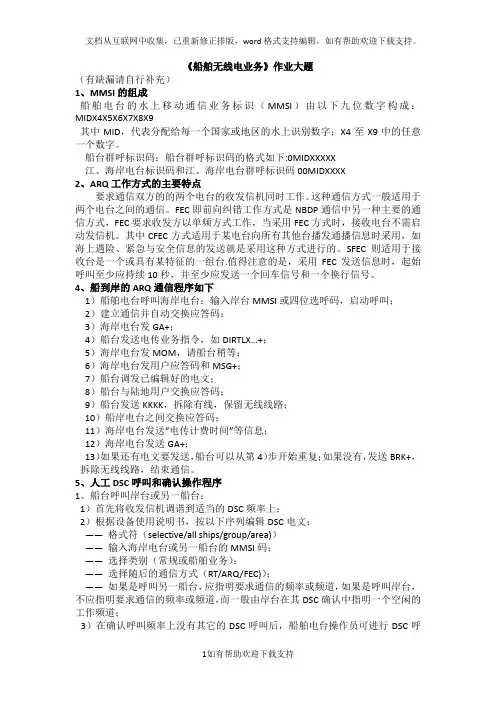
《船舶无线电业务》作业大题(有缺漏请自行补充)1、MMSI的组成船舶电台的水上移动通信业务标识(MMSI)由以下九位数字构成:MIDX4X5X6X7X8X9其中MID,代表分配给每一个国家或地区的水上识别数字;X4至X9中的任意一个数字。
船台群呼标识码:船台群呼标识码的格式如下:0MIDXXXXX江、海岸电台标识码和江、海岸电台群呼标识码00MIDXXXX2、ARQ工作方式的主要特点要求通信双方的的两个电台的收发信机同时工作。
这种通信方式一般适用于两个电台之间的通信。
FEC即前向纠错工作方式是NBDP通信中另一种主要的通信方式,FEC要求收发方以单频方式工作,当采用FEC方式时,接收电台不需启动发信机。
其中CFEC方式适用于某电台向所有其他台播发通播信息时采用,如海上遇险、紧急与安全信息的发送就是采用这种方式进行的。
SFEC则适用于接收台是一个或具有某特征的一组台.值得注意的是,采用FEC发送信息时,起始呼叫至少应持续10秒,并至少应发送一个回车信号和一个换行信号。
4、船到岸的ARQ通信程序如下1)船舶电台呼叫海岸电台:输入岸台MMSI或四位选呼码,启动呼叫;2)建立通信并自动交换应答码;3)海岸电台发GA+;4)船台发送电传业务指令,如DIRTLX…+;5)海岸电台发MOM,请船台稍等;6)海岸电台发用户应答码和MSG+;7)船台调发已编辑好的电文;8)船台与陆地用户交换应答码;9)船台发送KKKK,拆除有线,保留无线线路;10)船岸电台之间交换应答码;11)海岸电台发送“电传计费时间”等信息;12)海岸电台发送GA+;13)如果还有电文要发送,船台可以从第4)步开始重复;如果没有,发送BRK+,拆除无线线路,结束通信。
5、人工DSC呼叫和确认操作程序1、船台呼叫岸台或另一船台:1)首先将收发信机调谐到适当的DSC频率上;2)根据设备使用说明书,按以下序列编辑DSC电文:—— 格式符(selective/all ships/group/area))—— 输入海岸电台或另一船台的MMSI码;—— 选择类别(常规或船舶业务);—— 选择随后的通信方式(RT/ARQ/FEC));—— 如果是呼叫另一船台,应指明要求通信的频率或频道,如果是呼叫岸台,不应指明要求通信的频率或频道,而一般由岸台在其DSC确认中指明一个空闲的工作频道;3)在确认呼叫频率上没有其它的DSC呼叫后,船舶电台操作员可进行DSC呼叫。
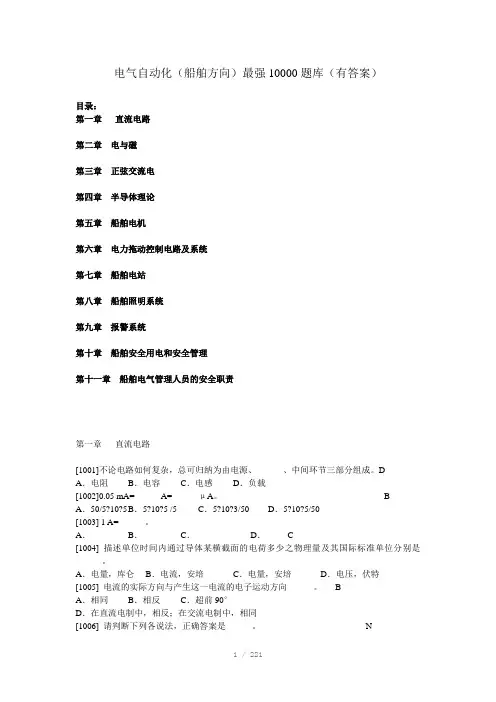
电气自动化(船舶方向)最强10000题库(有答案)目录:第一章直流电路第二章电与磁第三章正弦交流电第四章半导体理论第五章船舶电机第六章电力拖动控制电路及系统第七章船舶电站第八章船舶照明系统第九章报警系统第十章船舶安全用电和安全管理第十一章船舶电气管理人员的安全职责第一章直流电路[1001]不论电路如何复杂,总可归纳为由电源、______、中间环节三部分组成。
DA.电阻B.电容C.电感D.负载[1002]0.05 mA=______A=______μA。
B A.50/5?10?5 B.5?10?5 /5 C.5?10?3/50 D.5?10?5/50[1003] 1 A=______。
A.B.C.D. C[1004] 描述单位时间内通过导体某横截面的电荷多少之物理量及其国际标准单位分别是______。
A.电量,库仑B.电流,安培C.电量,安培D.电压,伏特[1005] 电流的实际方向与产生这一电流的电子运动方向______。
BA.相同B.相反C.超前90°D.在直流电制中,相反;在交流电制中,相同[1006] 请判断下列各说法,正确答案是______。
N(1)人们习惯以正电荷的运动方向作为电流的参考方向;(2)人们习惯以负电荷的运动方向作为电流的参考方向;(3)人们习惯以正电荷的运动方向作为电流的实际方向。
A.(1)错,(2)、(3)对B.(1)、(2)错,(3)对C.(1)对,(2)、(3)错D.(1)、(2)对,(3)错[1007]电源是将_____的装置。
CA.电能转换为热能B.电能转换为磁场能C.非电能转换为电能D.能量互换[1008] 300 μV =______mV =______V。
BA.3×105/0.3 B.0.3/3×10-4 C.0.3/3×10-6 D.3/3×10-5[1009] 1 V=______。
A.B.C.D.[1010] 关于电位与参考电位的概念,下列说法正确的是______。
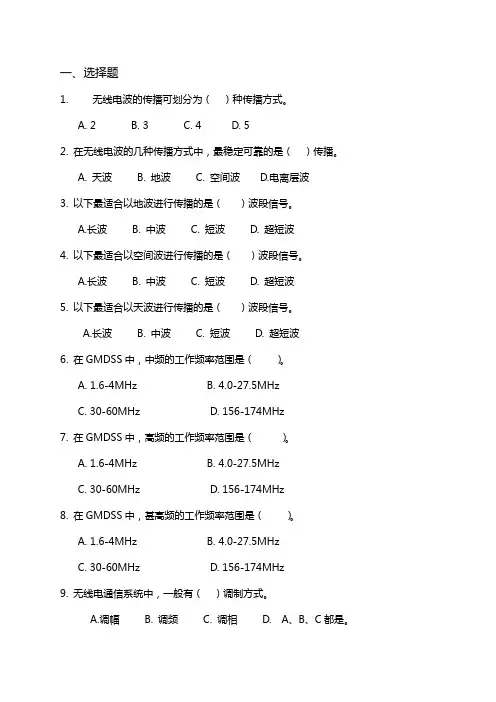
一、选择题1.无线电波的传播可划分为()种传播方式。
A. 2B. 3C. 4D. 52. 在无线电波的几种传播方式中,最稳定可靠的是()传播。
A. 天波B. 地波C. 空间波D.电离层波3. 以下最适合以地波进行传播的是()波段信号。
A.长波B. 中波C. 短波D. 超短波4. 以下最适合以空间波进行传播的是()波段信号。
A.长波B. 中波C. 短波D. 超短波5. 以下最适合以天波进行传播的是()波段信号。
A.长波B. 中波C. 短波D. 超短波6. 在GMDSS中,中频的工作频率范围是()。
A. 1.6-4MHzB. 4.0-27.5MHzC. 30-60MHzD. 156-174MHz7. 在GMDSS中,高频的工作频率范围是()。
A. 1.6-4MHzB. 4.0-27.5MHzC. 30-60MHzD. 156-174MHz8. 在GMDSS中,甚高频的工作频率范围是()。
A. 1.6-4MHzB. 4.0-27.5MHzC. 30-60MHzD. 156-174MHz9. 无线电通信系统中,一般有()调制方式。
A.调幅B. 调频C. 调相D. A、B、C都是。
10. 对调幅、单边带、调频无线电话通信的带宽作比较,应是()。
A. 调幅>单边带>调频B. 调频>单边带>调幅C. 调幅>调频>单边带D. 调频>调幅>单边带11. 单边带接收机中,从中频信号中还原音频信号所应采用的电路是()。
A. 幅度检波器B. 同步(乘积)检波器C. 鉴频器D. 鉴相器12. GMDSS的首要功能是()。
A、日常通信B、播发海上安全信息C、驾驶台与驾驶台通信D、遇险船舶的可靠通信13.GMDSS的遇险报警至少包含的信息是()。
A、船位B、船舶的识别C、船舶的遇险时间D、A和B14.GMDSS设备的配备是按()要求进行的。
A、船舶吨位B、各国配备规范C、船舶航区D、船舶动力装置的功率15.海上安全信息播发系统,由系统()组成。
GMDSS课后题(题库+答案)上海海事大学预览说明:预览图片所展示的格式为文档的源格式展示,下载源文件没有水印,内容可编辑和复制1.试设计A3海区国际航行船舶双套无线电通信设备的配备要求。
(P8,9) 答:序号设备名称A3海区设备数量要求方案一方案二1 甚高频无线电话(VHF) 1 12 奈伏泰斯接收机(NA VTEX) 1 13 极轨道卫星紧急无线电示位标406MHZ--EPIRB 1 14 甚高频紧急无线电示位标(VHF-EPIRB)5 中频无线电装置(MF) 16 中/高频无线电装置(MF/HF) 17 船舶地面站(SES) 18 强化群呼接收机(EGC) 1 19 救生艇筏双向甚高频无线电话(TWO-WAY VHF)3 310 搜救雷达应答器(SART) 2 2附加无线电通信设备的配备:序号设备名称A3海区设备数量要求1 甚高频无线电话(VHF) 12 中频无线电装置(MF)3 中/高频无线电装置(MF/HF)任选一个4 船舶地面站(SES)2.试述船舶GMDSS无线电人员的资格证书等级及业务范围(P10,11)资格证书分类:一级无线电电子证书(1st REC),二级无线电电子证书(2nd REC),通用操作员证书(GOC),限定操作员证书(ROC)。
业务范围:1st REC和2nd REC适用于A1,A2,A3或A4海区航行的船舶,海上平台或设施; GOC适用于A1,A2,海区航行的船舶,海上平台或设施;A3、A4海区航行的双套设备配备的船舶,海上平台或设施;ROC只适用于A1,海区航行的船舶,海上平台或设施。
3.哪些是不同航行海区船舶都要配备的GMDSS设备?所述它们的主要功能。
(8,256,280,285,239)I甚高频无线电话(VHF):用来实现船岸间或船舶间近距离通信,同时通过海岸/港口VHF 电台的转接实现船舶电台与陆地公众网用户间的电话通信。
II奈伏泰斯接收机(NA VTEX):储存、记忆功能;自动接收和打印功能;自诊断功能III救生艇筏双向甚高频无线电话(TWO-WAY VHF)主要用于救生艇筏之间、救生艇筏与船舶之间、以及救生艇筏与救助单位之间的现场通信。
海事服务考试试题题库答案一、单选题1. 船舶在海上遇到紧急情况时,应首先采取的行动是什么?A. 立即向最近的港口报告B. 尝试自行解决问题C. 发出遇险信号D. 等待其他船只救援答案:C2. 根据《国际海上人命安全公约》(SOLAS),船舶在夜间应如何显示其灯光?A. 仅显示舷灯B. 显示舷灯和尾灯C. 显示舷灯、尾灯和桅灯D. 显示所有灯光答案:C二、多选题1. 船舶在航行中需要遵守的海事法规包括以下哪些?A. 《国际海上人命安全公约》B. 《国际防止船舶造成污染公约》C. 《国际海事组织公约》D. 《联合国海洋法公约》答案:A, B, D2. 船舶在遇到以下哪些情况时,需要立即采取避碰措施?A. 遇到其他船舶横越船头B. 发现前方有漂浮物C. 遇到恶劣天气D. 发现其他船舶失控答案:A, D三、判断题1. 船舶在任何情况下都不得排放油类物质入海。
(错误)解析:根据《国际防止船舶造成污染公约》(MARPOL),船舶在特定条件下可以排放经过处理的油类物质。
2. 船舶在航行中必须随时保持无线电通信的畅通。
(正确)解析:无线电通信是船舶与外界联系的重要手段,保持通信畅通对于船舶安全至关重要。
四、简答题1. 简述船舶在海上遇到火灾时的应急措施。
答案:船舶在海上遇到火灾时,应立即启动火灾应急预案,关闭所有可能助燃的通风口,使用灭火器或消防水进行灭火,同时组织船员进行疏散,并向最近的港口或搜救中心发出求救信号。
2. 解释船舶在航行中如何遵守避碰规则。
答案:船舶在航行中应遵循《国际海上避碰规则》(COLREGs),包括保持适当的瞭望,使用适合当时环境和情况的航速,以及在必要时采取避碰行动,如改变航向或航速,以避免与其他船舶发生碰撞。
五、案例分析题案例:一艘货轮在夜间航行时,突然发现一艘渔船横越其船头。
货轮立即采取了避碰措施,但最终两船还是发生了碰撞。
请分析可能的原因及责任。
答案:可能的原因包括货轮瞭望不充分,未能及时发现渔船;渔船未能遵守避碰规则,未能给予货轮足够的避让空间;夜间能见度低,增加了避碰的难度。
中华人民共和国海事局2006年第1期海船船员适任证书全国统考试题(总第39期)科目:船舶电气试卷代号:851适用对象:3000KW及以上船舶二/三管轮(本试卷卷面总分100分,及格分为70分,考试时间为100分钟)答题说明:本试卷试题均为单项选择题,请选择一个最合适的答案,并将该答案按答题卡要求,在其相应位置上用2B铅笔涂黑。
每题1分,共100分。
1. 非电场力把单位正电荷从低电位处经电源内部移到高电位处所作的功是______。
A.电压B.电动势C.电位D.电场强度2. 关于电位与参考电位的概念,下列说法错误的是:A.电路中某点的电位等于该点与参考点之间的电位差B. 电位和电压的单位一致C.在一个电路中,可任选取一点,令其电位为零D.在同一个电路或电气系统中,可视分析的方便,选电路中不直接与导线相连的两点为参考电位点3. 关于两个电容器相串联,下列说法正确的是:A.两个电容器的电压之和等于电源电压B.每个电容器上的电压值与其电容值成正比C.等效电容为两个电容之和D.总电量Q为两个电容器所带电量之和4. 如右图所示,b点电位Vb=______V。
A. -15B. 15C. -5D. 55. 关于多个电阻相并联,下列说法正确的是:A.总的等效电阻值一定比这多个电阻中阻值最小的那个电阻值还要小B.总的等效电阻值一定比这多个电阻中阻值最小的那个电阻值略大一点C.总的等效电阻值不一定比这多个电阻中阻值最小的那个电阻值还要小D.总的等效电阻值一定介于这多个电阻中阻值最小及最大的二个电阻值之间6. 能定量地反映磁场中某点的磁场强弱的物理量是:A.磁通密度B.磁力线C.磁通D.电磁力7. 一直流电站在某次特大短路事故后,发现汇流排母线被强行拉弯,原因是______,弯曲的方向由______决定。
A.由于短路电流太大,形成较大的电场力造成的 / 短路时母线中的电流方向B.由于短路电流太大,形成较大的电磁力造成的 / 母线的截面积C.由于短路电流太大,形成较大的电场力造成的 / 母线的截面积D.由于短路电流太大,形成较大的电磁力造成的 / 短路时母线中的电流方向8. 应用左手定则来确定通电导体在磁场中的受力方向,其中正确的图示是:(图中箭头表示导体受力方向、分别表示面向纸面时导体中的电流流进、流出方向)A. B. C. D.9. 铁心线圈通以交变电流后,与线圈绝缘的铁心会发热,这是由于:A.电流的磁效应B.电流的力效应C.线圈中的电流产生热效应D.线圈中的电流产生热效应及铁损引起的热效应10. 正弦交流电的三要素是:A.最大值,有效值,初相位B.角频率,频率,周期C.最大值,角频率,相位差D.最大值,频率,初相位11. 把一个周期性交变的电流i和一个直流电流I 分别通过阻值相同的电阻R,在相同的时间内,若它们在电阻上产生的热效应相同,则该直流电流I大小对应交变电流i的:A.最大值B.有效值C.瞬时值D.平均值12. 如图,瓦特计的读数为2KW,U=230V,f=50Hz,现将一纯电感L=0.1H并接到电路中,则瓦特计的读数为:A. 2KWB. 3.68KWC. 0.32KWD. 2.61KW13. 电阻R、电容C、电感L三者并联,接在50Hz的交流电源上,此时R=XL=XC,当频率增加到60Hz时,R、XL、XC将如何变化?A. R不变,XL减小,XC减小 B. R不变,XL减小,XC增大C. R不变,XL增大,XC减小 D. R不变,XL不变,XC不变14. 在RL串联交流电路中,电路的阻抗为|Z|,感抗为XL,总有效电压为U,电阻电压为UR,有功功率为P,无功功率为Q,下面表示功率因数的表达式中,正确的是:A.B.C.D.15. 若三相电动势eA、eB、eC对称,按照电量符号的规定,则有:A. eA+eB+eC=3E B. eA+eB+eC=0 C. EA+EB+EC=0 D. EA+EB+EC=1.732E16. 在三相四线制供电线路上,干路中线:A.应装熔断器B.不允许装熔断器C.应按额定电流值装熔断器D.视具体情形而定17. 三相电路中,对称负载是星形接法,三相无功功率Q =______。
学年度第一学期期末考试《海上无线电通信设备及业务》(八)卷专业班级姓名学号一、单选题(每题的备选答案中只有一个量佳答案,每题2分,共30分)【、下列几种情况中会产生电磁波的是()A.用电锯锯铝材时迸出火花B.用声纳探测海底时接收到海底反射来的波C.敲击音叉时,音叉高速振动D.微波炉产生微波2、太阳发出可见光的同时还发射出其他频率的电磁波,这些电磁波在射向地球时波长、频率都不同,所以它们的波速().A.频率高的电磁波波速大8.一样大C.波长长的电磁波波速大D.由于速度=波长X频率,波长、频率不一定,所以无法判断3、电视台发射出•列波长为10米的无线电波,则它的频率大约是()A.30赫兹B.30千赫C.30兆赫D.无法计算4、用声纳探测海底时,已知海水深度为1531米,从发出信号到接收到信号共用了2s,在2s内声波共振动2x10”求所用声纳发出超声波的波长为()A、约1.53χ1.0''米B、约7.66x10'米C、约3.83x10'米D、约1.53x10”米5、无线电的发射与接收装置中的调谐版,其作用是()。
A.产生高频率振荡电流B,使高频率电流随声音信号变化C.得到所需要的带有声音信号的高频率振荡电流D.把信号还原成声音6、一列波在4秒内传播了400米,已知它的波长为10厘米,在这4秒钟内这列波共振荡了()次。
A.1000次B.40次C.1000次D.10次7、无线电干扰大致可分为()级。
Λ.3级B.4级C5级D.6级8、在GSM基站测试中,测得某发射机的工作频率为950.200MHz,该发射机工作在()信道.A.86B.76C.66D.969、当外界存在一个很强的干扰信号,由于收信机的非线性仍能造成对有用信号增益的降低(受到抑制)或噪声提高,使接收机灵敏度下降,这种干扰称为<)干扰。
A.同频道B.邻道C.杂散辐射D.阻塞10、19世纪60年代,英国物理学家()在总结前人研究电磁现象成果的基础上,建立了完整的电磁场理论。
1.GPS导航系统由哪几部分组成,各自作用?131空间段、地面段、用户设备空间段:接收地面监测和控制系统提供的数据和轨道参数,向用户发射信号地面段:向卫星提供一系列的数据描述为性运动及轨道参数;监测卫星沿着预定轨道运行;保证各个卫星与GPS系统时间同步以及监控卫星上各个设备的工作状况用户设备:用户设备即GPS接收机,是接收GPS卫星信号进行导航的设备。
2.GPS卫星导航系统共由几颗卫星构成卫星网?船舶利用其定位至少需几颗卫星?GPS卫星导航系统卫星轨道高度、倾角、周期是多少?卫星信号频率有几种,各为多少?130GPS卫星导航系统共由24颗卫星构成卫星网,船舶利用其定位至少需4颗卫星;GPS卫星导航系统卫星轨道高度是20183KM、倾角55°、周期是约12 小吋(717.98min)卫星信号频率有2种,分别为LI 1575.42MHz和L21227.60MHz 3.试述GPS导航系统定位的基本原理。
135定位原理:卫星星历:计算出卫星发出信号时的位置传播延吋:计算岀卫星与用户的距离传播延时、光速、多普勒频移:计算用户的三维运行速度;用第四颗卫星來计算用户时钟偏差;用户位置方程应包含三维空间和用户时钟偏差。
4.简述GPS卫星导航仪的主要功能135。
(1)显示定位的经度、纬度(2)显示导航数据:航速、航向、至航路点操舵航向和距离、航行吋间、偏航(3)能储存航线设计和航路点编号及其经纬度(4)位置更新时间约Iso(5)导航数据更新时间约3-5so(6)报警:偏航、守锚监视、到达航路点的范围、接收机故障等。
(7)能够设置一些参数:HDOP,二维(2D)定位,三维(3D)定位。
(8)变换使用测地系:一般有WGS84东京(TOKYO)、北美(NAD72)(9)接口功能:采用NMEA数据格式。
(10)卫星信息:卫星号,方位,仰角,工作状态,信噪比。
(11)星座预报。
(12)三维定位中,高度的精度正常允许在±50m内波动。
1.____是船舶电台的呼号A. 9VGB. BAAD1C. XSF26D. BOAD2.电台工作日志,国内各类来往电报保管期为____A. 半年/一年B. 一年/二年C. 一年/半年D. 二年/一年3.气象报告和航行警告的保管期为____A. 半年B. 三个月C. 一年D. 二年4.GMDSS船舶无线电人员需每天至少提供____无线电时间信号以修正船舶天文钟A. 一次B. 二次C. 三次D. 四次5.现场通信使用无线电话频率应选择____A. 156.8MHzB. 2182KHzC. 2174.5KHzD. A和B6.DSC遇险呼叫中, 如通信方式使用无线电话,应选择____A. 2187.5/2177.0KHZB. 2187.5/2182.0KHZC. 2187.5/4177.5KHZD. 2187.5/2174.5KHZ7.____不是DSC遇险呼叫频率和无线电话遇险通信频率A. 6312.0/6215.0B. 2187.5/2182.0C. 8414.5/8376.5D. 12577/12290.08.船舶在A2海区遇险使用DSC报警,频率应为____A. 2182KHzB. 2174.5KHzC. 2191KHzD. 2187.5KHz9.当航空器参与协调救助作业时可使用的频率____A. 3023KHzB. 5680KHzC. 156.8MHzD. A、B、C均是10.使用无线电传进行现场通信频率应是____A. 2174.5KHzB. 2182.0KHzC. 2187.5KHzD. CH16频道11.____是用于海岸电台以FEC方式发送MSI的频率A. 8291KHzB. 8376.5KHzC. 8415KHzD. 8416.5KHz12.使用中频进行国际DSC常规呼叫时应选择____频率A. 458.5/455.5KHZB. 2187.5/2187.5KHZC. 4208.0/4219.5KHZD. 6312.5/6331.0KHZ13.____不是DSC遇险呼叫频率A. 2187.5KHzB. 2182.0KHzC. 8414.5KHzD. 4207.5KHz14.救生艇手提式VHF双向无线电话,必须具备____频道A. CH6B. CH16C. CH70D. CH1315..国际上规定VHF 6频道用于____A. 无线电遇险和安全通信B. 船舶雾航避让,防台联系C. 船-船有关航行安全的通信D. 船舶与航空器之间进行协调搜救行动通信16.在GMDSS中,要求VHF无线电话设备应能在____频道上发送和接收DSC信息A. 6B. 13C. 16D. 7017..救生艇手提式双向无线电话工作频道要求____A. VHFCH16和至少另外一个频道B. VHFCH16和至少另外二个频道C. VHFCH16和至少另外一个单工频道D. VHF任意二个频道18.船岸台进行ARQ通信时,工作频率应选用____A. 非成对频率B. 指定的成对频率C. 自定任选频率D. A. B. C均是19.在GMDSS中,使用NBDP设备进行遇险通信的频率应是____A. 收、发频率相同B. 收、发频率不同C. 发射频率高于接收频率D. 接收频率高于发射频率20.在NBDP遇险通信中,对干扰电台强制静默使用信号_____A. SILENCE MAYDAYB. SEELONCE MAYDAYC. SEELONC EFINID. SILENCE FEENEE21.无线电话遇险通信中,遇险通信结束恢复正常工作使用信号_____A. SILENCE FINIB. SEELONCE FEENEEC. SEELONCE FINID. SILENCE FEENEE22.无线电传遇险通信中,恢复正常工作使用信号_____A. QUMB. SEELONCE FEENEEC. SEELONCE MAYDAYD. SILENCE FINI23._____是海岸电台的呼号A. 9VG98B. XSFC. XSG26D. A、B、C都是24.组成海岸电台呼叫识别的结构为____A. 0MIDX5X6X7X8X9B. 00MIDX6X7X8X9C. 000MIDX7X8X9D. MIDX4X5X6X7X8X925.水上移动业务识别为041234500是船舶电台标识的____A. 区域型式B. 国内型式C. 全球型式D. 成组呼叫识别26.水上识别数字(MID)的首位数是6代表的区域是____A. 非洲B. 南美洲C. 欧洲D. 大洋洲27.____是我国船舶电台的MMSIA. 047735000B. 004122100C. 412123000D. 21944257328.MMSI标识由____数字组成A. 三位B. 五位C. 七位D. 九位29.水上移动业务标识(MMSI)为412345670是船舶电台的____A. 国内型式B. 区域型式C. 全球型式D. 群呼型式30.海上移动业务识别中,中国的海上识别码(MID)为____A. 085B. 086C. 581D. 41231.____是INMARSAT-B站海上移动业务识别码(IMN)A. 341234610B. 441234650C. 1570174D. 41254181032.海事卫星水上移动业务识别码结构为TX1X2…Xk,其中T是用于区分海事卫星不同的系统,当T为0时表示为____A.A标准移动业务B. A标准群呼C. B标准移动业务D. A标准特别业务33.____应是C船站的IMNA. 1570152B. 441210810C. 004212100D. 41212300034.在我国的陆上用户电传应答码中,我国的国家标识用____表示A. CHINAB. CHNC. CND. CY35.无线电话遇险信号由____组成A. PANPANB. SOSC. MAYDAYD. SECURITE36.无线电传的紧急信号是____A. PANPANB. PANPAN三次C. XXXD. XXX三次37.在GMDSS中,无线电话的安全信号是由____组成的A. SECURITEB. PANPANC. MAYDAYD. XXX38.船舶在HF/DSC上收到DSC遇险报警,____后仍无海岸电台发射收妥承认,则该船台应进行遇险报警转播。
《船舶无线电业务》作业大题
(有缺漏请自行补充)
1、MMSI的组成
船舶电台的水上移动通信业务标识(MMSI)由以下九位数字构成:MIDX4X5X6X7X8X9
其中MID,代表分配给每一个国家或地区的水上识别数字;X4至X9中的任意一个数字。
船台群呼标识码:船台群呼标识码的格式如下:0MIDXXXXX
江、海岸电台标识码和江、海岸电台群呼标识码00MIDXXXX
2、ARQ工作方式的主要特点
要求通信双方的的两个电台的收发信机同时工作。
这种通信方式一般适用于两个电台之间的通信。
FEC即前向纠错工作方式是NBDP通信中另一种主要的通信方式,FEC要求收发方以单频方式工作,当采用FEC方式时,接收电台不需启动发信机。
其中CFEC方式适用于某电台向所有其他台播发通播信息时采用,如海上遇险、紧急与安全信息的发送就是采用这种方式进行的。
SFEC则适用于接收台是一个或具有某特征的一组台.值得注意的是,采用FEC发送信息时,起始呼叫至少应持续10秒,并至少应发送一个回车信号和一个换行信号。
4、船到岸的ARQ通信程序如下
1)船舶电台呼叫海岸电台:输入岸台MMSI或四位选呼码,启动呼叫;
2)建立通信并自动交换应答码;
3)海岸电台发GA+;
4)船台发送电传业务指令,如DIRTLX…+;
5)海岸电台发MOM,请船台稍等;
6)海岸电台发用户应答码和MSG+;
7)船台调发已编辑好的电文;
8)船台与陆地用户交换应答码;
9)船台发送KKKK,拆除有线,保留无线线路;
10)船岸电台之间交换应答码;
11)海岸电台发送“电传计费时间”等信息;
12)海岸电台发送GA+;
13)如果还有电文要发送,船台可以从第4)步开始重复;如果没有,发送BRK+,拆除无线线路,结束通信。
5、人工DSC呼叫和确认操作程序
1、船台呼叫岸台或另一船台:
1)首先将收发信机调谐到适当的DSC频率上;
2)根据设备使用说明书,按以下序列编辑DSC电文:
—— 格式符(selective/all ships/group/area))
—— 输入海岸电台或另一船台的MMSI码;
—— 选择类别(常规或船舶业务);
—— 选择随后的通信方式(RT/ARQ/FEC));
—— 如果是呼叫另一船台,应指明要求通信的频率或频道,如果是呼叫岸台,不应指明要求通信的频率或频道,而一般由岸台在其DSC确认中指明一个空闲的工作频道;
3)在确认呼叫频率上没有其它的DSC呼叫后,船舶电台操作员可进行DSC呼
叫。
4)等待对方确认
如果在首次呼叫后5min内,没有收到被呼叫台的确认(应答),船舶电台可在同一或不同的DSC频率上重复呼叫,若再没有收到被呼叫台的确认,则应等待至少15 min才能呼叫。
5)船舶电台一旦收到海岸电台或另一船台的DSC收妥确认,并且双方都同意在工作频率上进行通信,DSC程序即告完成。
6、DSC的试验
1、将发信机调谐到DSC遇险和安全频率上;
2、根据设备说明书,在DSC控制器键盘上选择DSC呼叫试验的格式;
3、在充分确认没有任何其它电台在此频率上进行DSC呼叫之后,发送DSC 呼叫;
4、等待海岸电台发送的DSC收妥承认。
一般情况下,海岸电台在收到船台DSC呼叫后的內会给予确认。
7、INMARSAT-A/B电话通信程序
1)电话通信前的准备
• 在发出电话呼叫前,MES的操作员应确认在航行的洋区中其MES的参数已设置正确。
如果可能,应准备好会话要点(在海上无线电通信中一般使用的国际语言为英语),要点应包括的关键内容如下:
• ——本船的识别号(ID);
• ——准备使用的LES的识别码;
• ——如果需要答复,应告知使用哪个洋区的卫星联络本船;
• ——需要呼叫的用户电话号码(包括电话国家码及区域码);
• ——通话内容的要点。
• 2)INMARSAT-B自动电话通信程序
• (1)选择电话通信方式(通常只需拿起电话话筒);
• (2)选择日常通信等级和信道种类(通常用“缺省”即可获得);
• (3)选择本船所在洋区的一个合适的岸站LES;
• (4)根据设备说明书启动呼叫,申请电话信道;
• 一般方法是先拨岸站识别码和“#”号;如868#,在约12s内会听到第二次拨号音,表明船站已与岸站沟通并分配了电话信道;如没收到任何信号,则应重新申请一次,如听到忙音,应稍等一会儿再呼叫。
(5)听到拨号音后、立即拨出下列号码(被叫用户不同,号码组成也不同):• 陆上用户:
• 自动业务代码00 电话国家码区域码用户电话号码结束符#
• 船站:
• 自动业务代码00 电话洋区码码被叫船站IMN 结束符#
• (6)与被呼用户通话,结束通话时用户挂机,计时停止;
• 通常,船站的打印机会打出通信时间和费用。
(7)主叫方挂机,拆除通信线路。
8、INMARSAT-A/B 电传通信的一般程序
(1)电传通信前的准备
• 在进行电传通信前,移动地球站操作员应确认船站的参数已设置正确
• 并利用在本机状态下的电文编辑功能将电文编辑准备好,然后存储到终端内存
中。
电传电文一般包括下列内容:
• ——收报人名址;
——发报人名址或船名/呼号/IMN/洋区;
• ——报文交发日期;
• ——电传索引号码/或电传内容主题;
• ——电传的优先等级(日常,可略);
• ——电传正文•
(2)通过卫星建立MES到本洋区LES的通信信道:
• ——在MES的终端选择电传工作方式;
• ——选择优先等级(缺省值为日常);
• ——在本船站所在的洋区内,选择呼叫所需通过的LES;
• ——键入地面站的识别码和“+”;
• 如用INM-B呼叫北京地面站键入868+
(3)建立地面站到最终用户的通信信道:
• 收到地面站发出的GA+时,应立即键入所需的业务和用户码,一般以下列的格式和次序键入:
• 陆上用户:
• 自动业务代码00 电传国家码用户电传码结束符+
• 船站用户:
• 自动业务代码00 电传洋区码被呼船站IMN 结束符+
(3)调取已存储的电传电文发送;
(4)如果通信结束,换行后再键入5个点“.....”拆线,随后会收到LES发出的日期时间组和通信计费时间。
9、MF DSC误报答的消除
• ①立即关掉收发信机;
• ②重新打开收发信机,并设定到2182KHz;
• ③向“所有电台”广播,提供船名、呼号和MMSI码并解除误报警。
10、NAVTEX 的技术编码B1B2B3B4
1)发射台的识别B1
2)电文种类标识B2
3)电文编号(B3B4)
―F电话遇险报警与确认程序
• 1. 按下遇险按钮保护盖,并选择遇险等级;
• 2. 拨合适的岸站识别码和“#”;
• 3. 通过所选择的岸站,与RCC沟通联络;
•4.向RCC发送遇险报告,格式如下:
• ——“MAYDAY”;
• ——遇险船名、呼号和IMN码或其它识别;
• ——遇险时间和船位;
• ——遇险性质和要求的援助;
• ——任何有利于救助的其它信息。
• ⑥放回话筒以拆线,回到值守状态。
―B电话遇险报警与确认程序
• ①拿起话筒;
• ②打开遇险按钮保护盖,并选择遇险等级;或按操作说明书,通过电话拨号盘直接进入遇险状态;
• ③拨合适的岸站识别码和“#”;
• ④通过所选择的岸站,与RCC沟通联络;
• 船站操作员无须选择电话号码,就能接通与岸站有联系的RCC 或岸站特殊值机员,并由它将遇险报警转到适当的RCC。
• ⑤向RCC发送遇险报告,格式如下:• ——“MAYDAY”;
• ——遇险船名、呼号和IMN码或其它识别;
• ——遇险时间和船位;
• ——遇险性质和要求的援助;
• ——任何有利于救助的其它信息。
• ⑥放回话筒以拆线,回到值守状态。
系统开放的主要业务有:
• 1)存储转发业务
• (1)电传业务
• (2)传真业务
(3)电子邮件业务
(4)船船通信业务
2)遇险通信业务
• 3)EGC业务
• (1)安全通信网(Safety NET)
• (2)船队通信网(Fleet NET)
• 4)数据报告与查询业务。